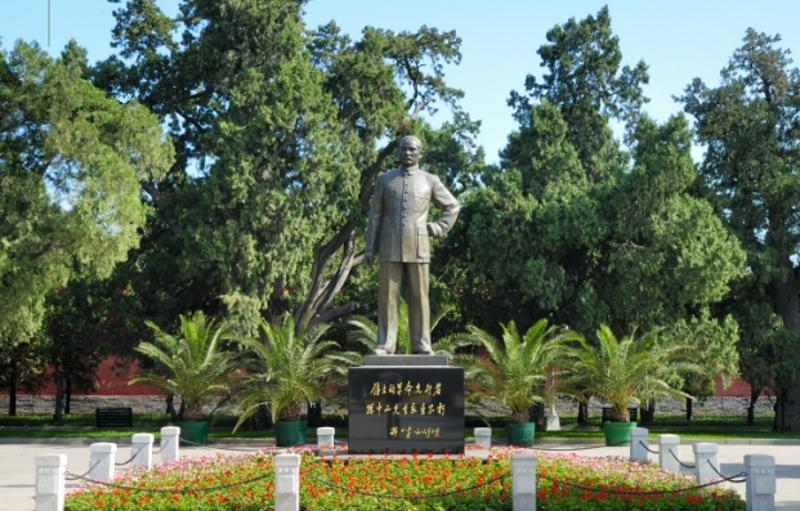The Sun Yat-sen Memorial Hall in Fragrant Hills, Beijing
Nestled at the foot of the picturesque Fragrant Hills Park in Beijing lies a historical Buddhist temple—Biyun Temple. Within this temple resides a special memorial hall—the Sun Yat-sen Memorial Hall. It is not only a place to commemorate a great figure but also a witness to modern Chinese history.

Reference: Beijing Fragrant Hills Park: Harmony of Nature and History
Location and Overview of the Memorial Hall
The Sun Yat-sen Memorial Hall is located deep within Fragrant Hills Park, about 10 kilometers west of downtown Beijing, precisely within Biyun Temple. With over 600 years of history, the temple stands tall, comprising four grand halls, with the deepest one being our focus today—the Sun Yat-sen Memorial Hall.
Interior Display of the Memorial Hall
Upon entering the memorial hall, visitors are greeted by a bust of Mr. Sun Yat-sen. His determined gaze seems to narrate the tumultuous era he lived in. Facing the bust is the entrance to the memorial hall, allowing every visitor to feel the charisma of this great man.
To the right of the bust, there is a quietly displayed empty coffin. A gift from the former Soviet government, it remained unused due to discrepancies in delivery time and Mr. Sun Yat-sen's passing. The coffin, covered in bronze and lined with glass, exudes solemnity and mystery.
Turning to the left, a series of letters and manuscripts are showcased. These precious documents were left behind by Mr. Sun Yat-sen upon his passing, recording the historical changes and the trail of thoughts of this great man.
Furthermore, embedded on the wall is a white marble stele with a letter from Mr. Sun Yat-sen to the former Soviet Union inscribed on it. This letter not only demonstrates Mr. Sun Yat-sen's international vision but also reflects his profound hopes for the country's future.
Exhibition Rooms on Both Sides of the Memorial Hall
The memorial hall features two exhibition rooms on either side. The first exhibition room primarily displays photos of Mr. Sun Yat-sen during his youth, portraying a youthful, vibrant, and idealistic image.
The second exhibition room mainly showcases photos of Mr. Sun Yat-sen's activities during the democratic revolution period. These photos vividly depict the vicissitudes of the era and Mr. Sun Yat-sen's revolutionary journey.
The Pagoda Courtyard Behind the Memorial Hall
Exiting the memorial hall and traversing through a tranquil pine forest, visitors arrive at the Pagoda Courtyard. Here stands a historically significant Vajrasana Pagoda, built during the Qianlong period, resembling the Wuta Temple in the northwest suburbs, showcasing a unique Buddhist artistic style.
This pagoda has deep connections with Mr. Sun Yat-sen. In 1925, Mr. Sun Yat-sen's coffin was temporarily placed inside this pagoda. Although the coffin was later moved to the Sun Yat-sen Mausoleum in Nanjing, his clothing and other personal belongings remain in the pagoda to this day, serving as a witness to history.
In front of the pagoda, there is a stone stele inscribed with a tribute from senior Kuomintang leader Hu Hanmin, expressing endless remembrance and respect for Mr. Sun Yat-sen.
Visiting Information for the Memorial Hall
If you wish to visit this historical sanctuary in person and experience the weighty historical sentiments, remember this: the Sun Yat-sen Memorial Hall is located on Xiangshan Road, Haidian District, Beijing. The ticket price is 10 yuan, and transportation is convenient, with multiple bus routes such as 360, 318, and 714 directly reaching Fragrant Hills Park.
Here, you can not only pay homage to a great man but also gain a deeper understanding of the changes and developments in modern Chinese history.
Question 1: What is the significance of the Sun Yat-sen Memorial Hall within Fragrant Hills Park in Beijing?
Answer: The Sun Yat-sen Memorial Hall holds historical significance as it commemorates the renowned figure Sun Yat-sen and serves as a witness to modern Chinese history. Located deep within Fragrant Hills Park, it stands within Biyun Temple, a temple with over 600 years of history. The memorial hall, comprised of four grand halls, including the main Sun Yat-sen Memorial Hall, preserves valuable artifacts and documents related to Sun Yat-sen's life and contributions, offering visitors insights into China's democratic revolution period and historical changes.
Question 2: How can visitors access the Sun Yat-sen Memorial Hall, and what can they expect to see inside?
Answer: Visitors can access the Sun Yat-sen Memorial Hall by traveling to Fragrant Hills Park, specifically to Biyun Temple, located about 10 kilometers west of downtown Beijing. Once inside, visitors will encounter a bust of Sun Yat-sen at the entrance, along with an empty coffin gifted by the former Soviet government. The memorial hall showcases letters, manuscripts, and a marble stele inscribed with a letter from Sun Yat-sen to the former Soviet Union. Additionally, two exhibition rooms display photos depicting Sun Yat-sen's youth and activities during the democratic revolution period. Behind the memorial hall lies the Pagoda Courtyard, housing a historically significant Vajrasana Pagoda, deeply intertwined with Sun Yat-sen's legacy.